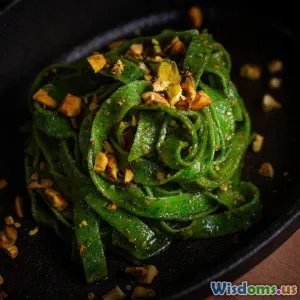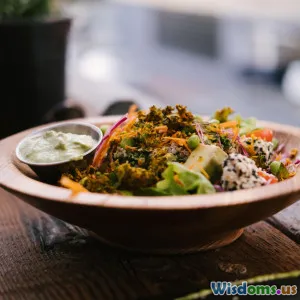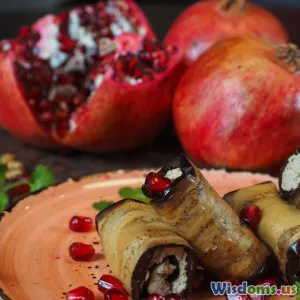
From Boring To Brilliant How Chimichurri Elevates Steak
8 min read Discover how chimichurri transforms steak from ordinary to extraordinary with vibrant flavors and cultural richness. (0 Reviews)
From Boring to Brilliant: How Chimichurri Elevates Steak
Introduction
Steak is a beloved dish worldwide, celebrated for its rich, hearty flavor and satisfying texture. Yet, despite its status, steak can sometimes fall into a familiar and predictable flavor pattern—rich, savory, but ultimately one-dimensional. Enter chimichurri, a vibrant sauce packed with herbs, garlic, and acidity. This simple yet transformative condiment has the power to take steak from boring to brilliant, infusing each bite with fresh, tangy notes that complement and elevate the meat’s natural flavors. This article explores the origins of chimichurri, its flavor profile, and how it revolutionizes the steak experience.
The Origins and Essence of Chimichurri
A South American Culinary Gem
Chimichurri hails from Argentina and Uruguay, where it serves as a staple accompaniment to grilled meats, particularly beef, which is integral to these countries’ culinary identities. The sauce embodies the spirit of the South American grill or "asado," a social event centered around grilled meats and lively conversation.
Beyond its cultural significance, chimichurri represents culinary wisdom: a fresh, herbaceous sauce rich in native flavors, carefully designed to cut through the boldness of fatty grilled meats, refreshing the palate and enhancing enjoyment.
Basic Chimichurri Ingredients
At its core, chimichurri is an uncooked sauce combining:
- Fresh parsley (the green foundation)
- Garlic (providing pungent intensity)
- Red pepper flakes or fresh chili (for spirited heat)
- Red wine vinegar or lemon juice (adding acidity)
- Olive oil (for binding and smoothness)
- Optional oregano or other herbs
Each ingredient works symbiotically to create a complex flavor profile: herbaceous, garlicky, acidic, slightly spicy, and rich.
Why Chimichurri Transforms Steak
Balancing Fat and Flavor
Steak—especially cuts like ribeye or sirloin—has a robust, fatty flavor and chewy texture that can become overwhelming. Chimichurri’s acidity (from vinegar or lemon) acts as a palate cleanser, cutting through the fat and preventing flavor fatigue. Similarly, the fresh parsley brightens the meat, introducing a crispness that contrasts with the richness.
Enhancing Umami
Garlic in chimichurri heightens the umami—the meaty savoriness—that steak delivers. The mild heat from chili flakes or fresh peppers awakens the taste buds, intensifying the overall sensory experience.
A Freshness Multiplier
Where steak alone can become monotonous, chimichurri brings an herbaceous surprise. This freshness adds layers of complexity, making each bite intriguing and delightfully different.
Chimichurri Variations to Suit Every Palate
Red vs. Green Chimichurri
Traditional green chimichurri emphasizes parsley, garlic, vinegar, and olive oil. In contrast, a red chimichurri incorporates additional ingredients like smoked paprika, fresh or dried red chilies, and often tomato paste, creating smoky warmth. Both types complement steak superbly but offer distinct experiences.
Regional and Personal Twists
In some Argentine regions, chimichurri includes cilantro or mint, rather than parsley, or even bell peppers for sweetness. Home cooks and chefs experiment with lemon zest, honey, or toasted nuts to add unique flavors and textures.
Exploring these variations allows diners to tailor the chimichurri experience, further personalizing the steak pairing.
Crafting the Perfect Chimichurri for Your Steak
Freshness is Key
Using fresh, high-quality parsley and garlic ensures brightness. Dull or old herbs won’t deliver the signature vibrant flavor.
Balance Acidity and Oil
Never skimp on vinegar or lemon juice, as these brighten and cut through steak’s richness. Olive oil must be good quality to provide smoothness without overpowering.
Let it Rest
Allowing chimichurri to rest for at least 30 minutes before serving lets flavors meld and intensify, yielding a more harmonious sauce.
Adjust to Taste
Everyone’s bouquet varies—add more garlic for pungency, or extra chili for heat, depending on preferences.
Expert Tips and Serving Suggestions
-
Serve Chimichurri on the Side: Allow guests to control how much sauce they want, keeping the steak moist and not overwhelming.
-
Marinating with Chimichurri: Traditionally a finishing sauce, chimichurri can double as a marinade, imparting flavor while tenderizing the steak.
-
Pairing with Cuts: Heavier sauces work beautifully with fattier cuts like ribeye or skirt steak; leaner cuts benefit from a lighter chimichurri dose.
-
Complementary Sides: Grilled vegetables, roasted potatoes, or fresh salads paired with chimichurri-coated steak create balanced meals.
-
Try Chimichurri-Inspired Variants: Use the base recipe to create dressings or condiments for other grilled meats, seafood, or even vegetables.
Real-World Insights
According to Argentinian chef Francis Mallmann, the power of chimichurri lies in its essential ability to lighten the impact of meat-filled meals without sacrificing flavor complexity. He notes, "Chimichurri is not just a sauce; it is the spirit of the asado, bringing guests together around an open flame and a common joy of shared flavor."
Studies reveal that compounds in parsley, such as apigenin, have antioxidant properties that may support digestion and overall health, adding wellness credentials to this beloved sauce.
Conclusion
Transforming a steak from ordinary to extraordinary often hinges on the accompaniment – and chimichurri epitomizes this principle. This vibrant sauce enhances, balances, and enlivens steak with its fresh herbs, bold acidity, and piquant spice. Whether you stick to the classic green chimichurri or experiment with regional variations, incorporating this sauce elevates steak’s flavor profile to new heights, providing a memorable, sensory-rich experience.
By embracing chimichurri, home cooks and chefs alike unlock the full potential of steak, turning a simple grilled cut into a celebration of flavor, culture, and culinary sophistication. Next time you fire up the grill, consider chimichurri not just an afterthought but the star partner to your steak.
Embrace the bold simplicity of chimichurri and enjoy steak the way it was meant to be savored—brilliantly fresh, intensely flavorful, and irresistibly satisfying.
Rate the Post
User Reviews
Popular Posts

















